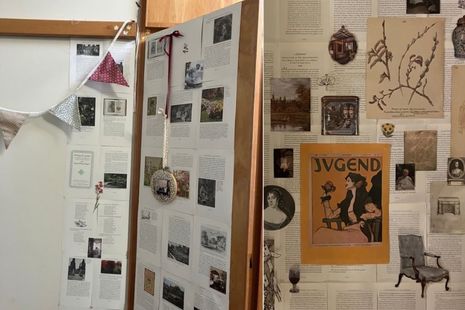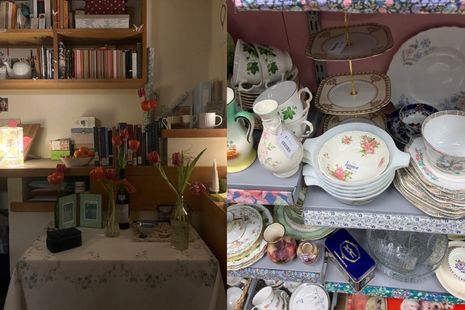A student’s guide to simple, low-cost university room decor
Ella Ducker offers her best room-decorating tips, inspired by ’50s housewifery manuals

Almost every incoming student sees herself as a good room-decorator. Before university, she pictures herself in a dream room; she is a charming hostess, perfect housewife-in-the-making and canny scholar all in one.
When she finds herself allocated to lodgings that are antiquated and dreary – or worse, modern and characterless – with neither the time nor money for a complete renovation, the vision is apt to tarnish.
Yet it shouldn’t. With a few quick furniture rearrangements, simple DIYs and small purchases, every room can be made a home!
Walls
When renting, the average drab magnolia wall owner’s greatest challenge is to leave no trace of her decor: to keep her deposit, she may use Command hooks and washi/masking tape when beautifying her walls. Homemakers should always begin by hanging bunting; gingham and floral flags transform every space. Posters are desirable.
Noticeboards
Any student looking for items to display on her noticeboard would do best to first pay a visit to her local charity shop – this is the ideal place to find old books, magazines, postcards, stamps, prints, etc. at a low price. When in Cambridge, browse at G. David (which sells excellent prints) and St Botolph’s book fairs.
To decorate a noticeboard:
Step 1: pin book pages, maps, sewing patterns or fabric across the whole board.

Step 2: collage on top with photographs, prints and notes from friends. Add to board throughout the year.
Lighting
Even the dingiest accommodation may be lit sufficiently by lamps with hessian shades and warm white LED bulbs without the occupant resorting to use of harsh overhead lighting. Fairy lights are advantageous additions.
Furniture
If her room is well-furnished with antique chairs, the lucky resident should do no more than add a couple of lace-trimmed scatter cushions. For the stained sofa or blue pleather ‘easy chair’, a throw is required. The student would also do well to purchase a mattress topper, for both hygiene and comfort, and patterned bed linen. Coffee-stained tables are best hidden under a tablecloth – Vinted has an excellent selection of vintage embroidered cloths at a low price.
Shelves and bookcases
Shelf-decorators should not underestimate the power of a beautiful book. Most publishers offer a line of collectible classics: these make for perfect bookshelf-candidates, although any charming book will do.

But the real trick is to acquire a large, eclectic collection of trinkets. Again, a visit to a charity shop is an excellent place to start. Bowls, vases, china teacups, glassware, decorative plates, odd little ornaments, pin cushions, packs of cards and jewellery boxes should be scattered along the shelves in a thoughtfully disordered manner. It is ideal if trinkets are both useful and attractive, but this is hardly necessary.
Room size
The student in possession of a large room perfect for hosting may find that her generous living-quarters feel rather empty in moments of solitude. Sizeable rooms should therefore be divided into ‘zones’. This is easily achieved with some quick furniture-rearranging to make areas for sleeping, working and hosting. Desks are best placed under windows. A rug is wisely purchased.

When it comes to decorating small lodgings, paler, more muted colour schemes give the appearance of spaciousness. However, the decorator should avoid the common mistake of thinking “less is more”. Quite the contrary; more is always more, and a small room feels cosy with the addition of soft furnishings, bunting and carefully selected trinkets.
Three easy DIYs
1. Buy flowers (baby’s breath or roses work well), hang upside down to dry in a cool, dark place for two weeks. Place dried flowers in empty wine bottles. The student now has flowers all year round without the cost of buying fresh bunches each week. Alternatively, press flowers between heavy books and tape to a wall or noticeboard.
2. Paint glass bottles and jam jars in which pencils, brushes and cutlery may be stored. Glass paint is desirable but acrylic sealed with Mod Podge will be sufficient.

3. The amateur sewer in possession of a sewing machine may easily make bunting from old scraps of fabric in just a few hours. A simpler and equally effective option is to make felt or paper garlands. Cut out shapes (flowers, stars, hearts, etc.) and sew or tape them along a piece of string/ribbon.
No student ever need despair at college accommodation again. By following this simple guide, even rooms with the tattiest furniture and tiredest walls will be transformed into homes worthy of the most delightful tea parties and bookish evenings.
If the maker is in luck, she may find craft supplies in charity shops. The Works offer a good, cheap range of materials, as does Flying Tiger, although their selection is less reliable. Sainsbury’s sells basic sewing kits. Sewers in search of fabric should visit Sew Knit Craft on King Street.
 Comment / Plastic pubs: the problem with Cambridge alehouses 5 January 2026
Comment / Plastic pubs: the problem with Cambridge alehouses 5 January 2026 News / Cambridge businesses concerned infrastructure delays will hurt growth5 January 2026
News / Cambridge businesses concerned infrastructure delays will hurt growth5 January 2026 News / New movement ‘Cambridge is Chopped’ launched to fight against hate crime7 January 2026
News / New movement ‘Cambridge is Chopped’ launched to fight against hate crime7 January 2026 News / AstraZeneca sues for £32 million over faulty construction at Cambridge Campus31 December 2025
News / AstraZeneca sues for £32 million over faulty construction at Cambridge Campus31 December 2025 Interviews / You don’t need to peak at Cambridge, says Robin Harding31 December 2025
Interviews / You don’t need to peak at Cambridge, says Robin Harding31 December 2025










